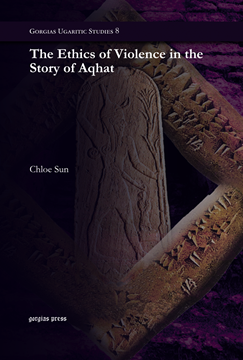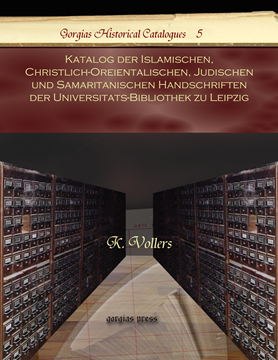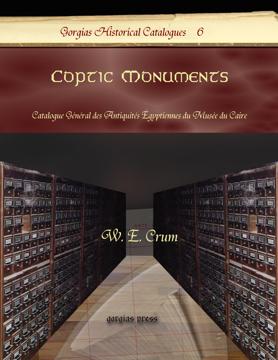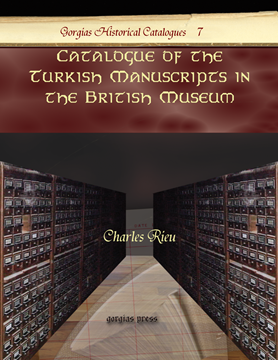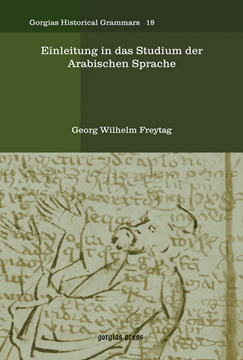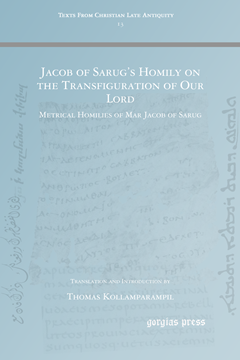The Ethics of Violence in the Story of Aqhat
By Chloe Sun
Series: Gorgias Ugaritic Studies 8
ISBN: 978-1-59333-975-3
An examination of the ethics of violence in the Ugaritic story of Aqhat using the conventions of characterization and the conflicting points of view. The points of view of the divine characters El, Baal, Anat, Yatpan, are contrasted with the points of view of the human characters, Aqhat, Dan'il and Pughat, in order to bring out the multi-dimensional aspect of Anat's violence.
$141.00 (USD) $84.60 (USD)
Katalog der Islamischen, Christlich-Oreientalischen, Judischen und Samaritanischen Handschriften der
By K. Vollers
Series: Kiraz Historical Catalogues Archive 5
ISBN: 978-1-59333-930-2
This catalogue presents the Islamic, Oriental Christian, Judaic and Samaritan manuscripts in the University library of Leipzig’s collection. The largest part of the material is Islamic, and it is presented here according to categories. Manuscripts are described by title (if known) and a brief summary of the contents. Dimensions for most of the pieces are given as well. The Christian material includes manuscripts in Arabic, Syriac, Coptic, Ethiopic, and Georgian. A numerical concordance adds to the utility of this important manuscript collection.
$211.00 (USD) $126.60 (USD)
Coptic Monuments
Catalogue Général des Antiquités Égyptiennes du Musée du Caire
By W. E. Crum
Series: Kiraz Historical Catalogues Archive 6
ISBN: 978-1-59333-931-9
In this historic catalogue, Crum presents the Coptic monuments of the Museum of Cairo. Although given a French title, the contents of this book are written in English. Some of the more striking items are presented with beautifully drawn sketches of relevant sections of the source. As a museum book, this catalogue is amply illustrated with 57 black and white plates. A variety of artifacts are described: manuscripts, ostraca, and stelae, and indices round out the utility of this volume. A specialized collection from early Christian Egypt, this book will be welcomed by specialists in Coptic materials still found in their native land.
$143.00 (USD) $85.80 (USD)
Catalogue of the Turkish Manuscripts in the British Museum
By Charles Rieu
Series: Kiraz Historical Catalogues Archive 7
ISBN: 978-1-59333-932-6
This volume records and describes the 483 Turkish manuscripts in the British Museum at the time of the author. Most of the manuscripts are in Western Turkish, and a few in Eastern. The material is helpfully categorized according to the area of particular concern to the manuscript. Various aspects of Islamic religious practice are covered by several manuscripts. Other general areas represented are history, sciences, the arts, philology, and poetry. The Eastern Turkish materials are given their own section. Each manuscript is meticulously described, and the volume contains useful indices of titles, personal names, and subjects. A must have for any Turkologist, this historic catalogue is once again available.
$174.00 (USD) $104.40 (USD)
Einleitung in das Studium der Arabischen Sprache
Series: Kiraz Historical Grammars Archive 18
ISBN: 978-1-59333-933-3
The introduction to the Arabic language by the renowned linguist Georg Freytag is fast becoming difficult to find. Written in German, this precise presentation is intended for a general readership which has no background in previous Semitic language study. The Arabic period covered for this historic grammar is that of Mohammed and later. In some ways an unconventional approach Freytag introduces topics such as Arabic names and the history of the Arabs, even prior to Mohammed’s time. An outline of the Arabic language and its dialects is presented. A period piece that retains its functionality, this introduction to Arabic is more than a grammar, it is a view into the life of the Arabian world.
$212.00 (USD) $127.20 (USD)
Jacob of Sarug’s Homily on the Transfiguration of Our Lord
Metrical Homilies of Mar Jacob of Sarug
Translation and Introduction by Thomas Kollamparampil
Series: Texts from Christian Late Antiquity 13
ISBN: 978-1-59333-934-0
This edition of Mar Jacob of Sarug's (d. 521) homily on the Transfiguration emphasizes the unity of the Old and New Testament. Jacob focuses on the symbolism of the apostles Jesus brings with him. Moses, the head of prophecy, and John, the beauty of apostleship, come together and Elijah and Simon are joined so that the keys Peter received over creation might be ratified. The volume constitutes a fascicle of The Metrical Homilies of Mar Jacob of Sarug, which, when complete, will contain the original Syriac text of Jacob's surviving sermons, fully vocalized, alongside an annotated English translation.
$36.00 (USD) $21.60 (USD)
